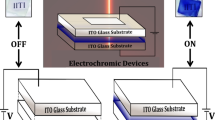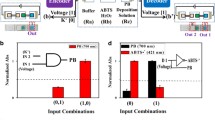Abstract
Thermodynamics is one of the most fascinating parts of physical chemistry, involved in different natural phenomena. In particular, the spontaneity or non-spontaneity of a chemical reaction is directly linked to fundamental thermodynamic parameters such as the Gibbs free energy change. Commonly this can be easily correlated with the electric work produced or required during an electrochemical reaction. In this context, the direct visualization of the electromotive force facilitates the student’s understanding of the fundamental concepts behind the spontaneity of coupled reactions. Herein, we take advantage of the concepts of endogenous and exogenous bipolar electrochemistry to develop an easy and straightforward approach for the introduction of the thermodynamic concept of spontaneity to undergraduate students. In such a wireless electrochemical approach, the chemical information of two coupled reactions is encoded by the light emission of a light-emitting diode employed as bipolar electrode. This results in a direct optical readout of thermodynamic information of the involved redox reactions.
Graphical Abstract





Similar content being viewed by others
References
Ochs RS (1996) Thermodynamics and spontaneity. J Chem Educ 73:952–954. https://doi.org/10.1021/ed073p952
da Silva RL, de Andrade J, Gasparotto LHS (2018) Electromotive force versus electrical potential difference: approaching (but not yet at) equilibrium. J Chem Educ 95:1811–1815. https://doi.org/10.1021/acs.jchemed.8b00249
Kuhn A (2020) To be, or not to be…Electrochemist? J Solid State Electrochem 24:2113–2114. https://doi.org/10.1007/s10008-020-04650-x
Fosdick SE, Knust KN, Scida K, Crooks RM (2013) Bipolar electrochemistry Angew Chem Int Ed 52:10438–10456. https://doi.org/10.1002/anie.201300947
Koefoed L, Pedersen SU, Daasbjerg K (2017) Bipolar electrochemistry-a wireless approach for electrode reactions. Curr Opin Electrochem 2:13–17. https://doi.org/10.1016/j.coelec.2017.02.001
Bouffier L, Zigah D, Sojic N, Kuhn A (2021) In Bard AJ, Stratmann M (ed) Encyclopedia of Electrochemistry, Wiley. https://doi.org/10.1002/9783527610426.bard030112
Rahn KL, Anand RK (2021) Recent advancements in bipolar electrochemical methods of analysis. Anal Chem 93:103–123. https://doi.org/10.1021/acs.analchem.0c04524
Shida N, Zhou Y, Inagi S (2019) Bipolar electrochemistry: a powerful tool for electrifying functional material synthesis. Acc Chem Res 52:2598–2608. https://doi.org/10.1021/acs.accounts.9b00337
Zhao Y, Descamps J, Le Corre B, Leger Y, Kuhn A, Sojic N, Loget G (2022) Wireless anti-stokes photoinduced electrochemiluminescence at closed semiconducting bipolar electrodes. J Phys Chem Lett 13:5538–5544. https://doi.org/10.1021/acs.jpclett.2c01512
Zhan W, Alvarez J, Crooks RM (2002) Electrochemical sensing in microfluidic systems using electrogenerated chemiluminescence as a photonic reporter of redox reactions. J Am Chem Soc 124:13265–13270. https://doi.org/10.1021/ja020907s
Xing H, Zhang X, Zhai Q, Li J, Wang E (2017) Bipolar electrode based reversible fluorescence switch using Prussian blue/Au nanoclusters nanocomposite film. Anal Chem 89:3867–3872. https://doi.org/10.1021/acs.analchem.7b00246
Qin X, Gao J, Jin HJ, Li ZQ, Xia XH (2023) Closed bipolar electrode array for optical reporting reaction-coupled electrochemical sensing and imaging. Chem Eur J 29:e2022026. https://doi.org/10.1002/chem.202202687
Liu Y, Zhang N, Pan JB, Song J, Zhao W, Chen HY, Xu JJ (2022) Bipolar electrode array for multiplexed detection of prostate cancer biomarkers. Anal Chem 94:3005–3012. https://doi.org/10.1021/acs.analchem.1c05383
Hsueh AJ, Mutalib NAA, Shirato Y, Suzuki H (2022) Bipolar electrode arrays for chemical imaging and multiplexed sensing. ACS Omega 7:20298–20305. https://doi.org/10.1021/acsomega.2c02298
Villani E, Inagi S (2021) Mapping the distribution of potential gradient in bipolar electrochemical systems through luminol electrochemiluminescence imaging. Anal Chem 93:8152–8160. https://doi.org/10.1021/acs.analchem.0c05397
Borchers JS, Riusech O, Rasmussen E, Anand RK (2019) Visual voltammogram at an array of closed bipolar electrodes in a ladder configuration. J Anal Test 3:150–159. https://doi.org/10.1007/s41664-019-00098-9
Borchers JS, Campbell CR, Van Scoy SB, Clark MJ, Anand RK (2021) Redox cycling at an array of interdigitated bipolar electrodes for enhanced sensitivity in biosensing. ChemElectroChem 8:3482–3491. https://doi.org/10.1002/celc.202100523
Defnet PA, Zhang B (2020) Detection of transient nanoparticle collision events using electrochemiluminescence on a closed bipolar microelectrode. ChemElectroChem 7:252–259. https://doi.org/10.1002/celc.201901734
Cesin-AbouAtme T, Lopez-Almeida CG, Molina-Labastida G, Ibanez JG (2021) Light-emitting diodes as voltage generators: demonstrating the fuel cell principle with low-cost, magnetically enhanced, homemade solar electrolysis. J Chem Educ 98:3045–3049. https://doi.org/10.1021/acs.jchemed.1c00093
Cheek GT (2015) Demonstrations of frequency/energy relationships using LEDs. J Chem Educ 92:1049–1052. https://doi.org/10.1021/ed5008553
Salinas G, Pavel IA, Sojic N, Kuhn A (2020) Electrochemistry-based light-emitting mobile systems ChemElectroChem 7:4853–4862. https://doi.org/10.1002/celc.202001104
Roche J, Carrara S, Sanchez J, Lannelongue J, Loget G, Bouffier L, Fischer P, Kuhn A (2014) Wireless powering of e-swimmers Sci Rep 4:6705. https://doi.org/10.1038/srep06705
de Poulpiquet A, Sojic N, Bouffier L, Kuhn A, Zigah D (2023) Wireless electronic light emission: an introduction to bipolar electrochemistry. J Chem Educ 100:767–773. https://doi.org/10.1021/acs.jchemed.2c00573
Salinas G, Beladi-Mousavi SM, Gerasimova L, Bouffier L, Kuhn A (2022) Wireless imaging of transient redox activity based on bipolar light-emitting electrode arrays. Anal Chem 94:14317–14321. https://doi.org/10.1021/acs.analchem.2c02872
Gupta B, Suchomski P, Melvin AA, Linfield S, Opallo M, Nogala W (2022) Optical readout of moisture in sand employing bipolar electrochemistry. Electrochem Commun 140:107329. https://doi.org/10.1016/j.elecom.2022.107329
Zhai J, Yang L, Du X, Xie X (2018) Electrochemical-to-optical signal transduction for ion-selective electrodes with light-emitting diodes. Anal Chem 90:12791–12795. https://doi.org/10.1021/acs.analchem.8b03213
Lau KT, Shepherd R, Diamond D, Diamond D (2006) Solid state pH sensor based on light emitting diodes (LED) as detector platform. Sensors 6:848–859. https://doi.org/10.3390/s6080648
Zhang X, Han Y, Li J, Zhang L, Jia X, Wang E (2014) Portable, universal, and visual ion sensing platform based on the light emitting diode-based self-referencing-ion selective field-effect transistor. Anal Chem 86:1380–1384. https://doi.org/10.1021/ac403312f
Cauteruccio S, Pelliccioli V, Grecchi S, Cirilli R, Licandro E, Arnaboldi S (2023) Bipolar electrochemical analysis of chirality in complex media through miniaturized stereoselective light-emitting systems. Chemosensors 11:131. https://doi.org/10.3390/chemosensors11020131
Salinas G, Arnaboldi S, Bonetti G, Cirilli R, Benincori T, Kuhn A (2021) Hybrid light-emitting devices for the straightforward readout of chiral information. Chirality 33:875–882. https://doi.org/10.1002/chir.23370
Salinas G, Bonetti G, Cirilli R, Benincori T, Kuhn A, Arnaboldi S (2022) Wireless light-emitting device for the determination of chirality in real samples. Electrochim Acta 421:140494. https://doi.org/10.1016/j.electacta.2022.140494
Zhang X, Chen C, Yin J, Han Y, Li J, Wang E (2015) Portable and visual electrochemical sensor based on the bipolar light emitting diode electrode. Anal Chem 87:4612–4616. https://doi.org/10.1021/acs.analchem.5b01018
Salinas G, Dauphin AL, Colin C, Villani E, Arbault S, Bouffier L, Kuhn A (2020) Chemo- and magnetotaxis of self-propelled light-emitting chemo-electronic swimmers. Angew Chem Int Ed 59:7508–7513. https://doi.org/10.1002/anie.201915705
Pavel IA, Salinas G, Perro A, Kuhn A (2021) Autonomous chemotactic light-emitting swimmers with trajectories of increasing complexity. Adv Intell Syst 3:2000217. https://doi.org/10.1002/aisy.202000217
Pyun SI (2020) Thermodynamic and electro-kinetic analyses of direct electron transfer (DET) and mediator-involved electron transfer (MET) with the help of a redox electron mediator. J Solid State Electrochem 24:2685–2693. https://doi.org/10.1007/s10008-020-04780-2
L-53HD Bright Red T-1 3/4 (5mm) Solid State Lamp specifications. https://docs.rs-online.com/824c/0900766b8151e40a.pdf
Sreenivasulu B, Subramaniam R (2012) University students’ understanding of chemical thermodynamics. Int J Sci Educ 35:601–635. https://doi.org/10.1080/09500693.2012.683460
Nagel ML, Lindsey BA (2015) Student use of energy concepts from physics in chemistry courses. Chem Educ Res Pract 16:67–81. https://doi.org/10.1039/C4RP00184B
Funding
The work has been funded by the European Research Council (ERC) under the European Union’s Horizon 2020 research and innovation program (grant agreement n° 741251, ERC Advanced grant ELECTRA).
Author information
Authors and Affiliations
Corresponding author
Additional information
Publisher's Note
Springer Nature remains neutral with regard to jurisdictional claims in published maps and institutional affiliations.
Rights and permissions
Springer Nature or its licensor (e.g. a society or other partner) holds exclusive rights to this article under a publishing agreement with the author(s) or other rightsholder(s); author self-archiving of the accepted manuscript version of this article is solely governed by the terms of such publishing agreement and applicable law.
About this article
Cite this article
Salinas, G., Bouffier, L., Sojic, N. et al. Light-emitting bipolar electrochemistry: a straightforward way to illustrate thermodynamic aspects to students. J Solid State Electrochem 28, 1225–1231 (2024). https://doi.org/10.1007/s10008-023-05690-9
Received:
Revised:
Accepted:
Published:
Issue Date:
DOI: https://doi.org/10.1007/s10008-023-05690-9




